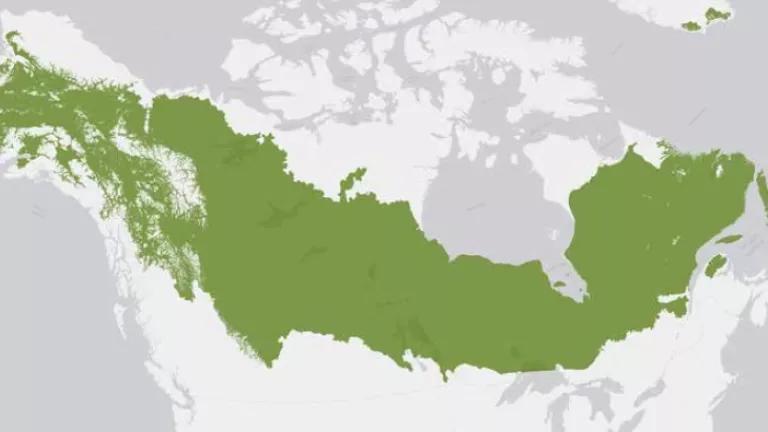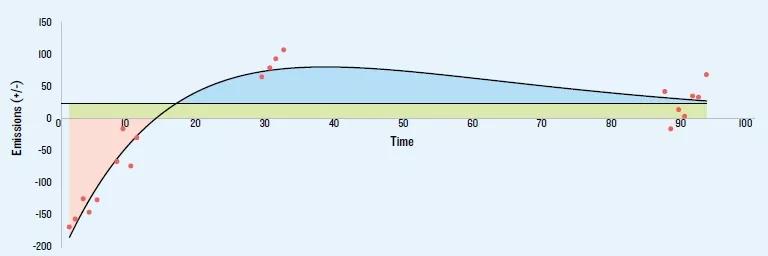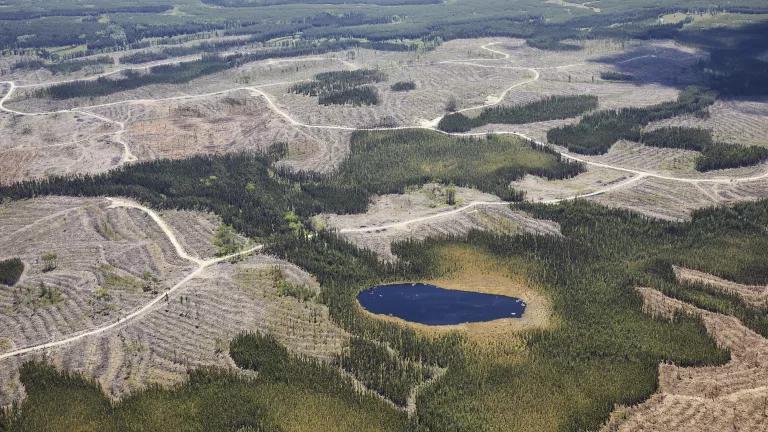Canada’s Boreal Clearcutting Is a Climate Threat
For the sake of the global climate, Canada must reign in boreal forest clearcutting and protect as much of this critical resource as possible.

Canada's boreal forest stretches from the Yukon Territory's border with Alaska to Newfoundland on Canada's east coast
As a new NRDC report demonstrates, an intact boreal forest is vital to mitigating the worst effects of global climate change. In the report, NRDC examines how clearcut logging in the boreal forest contributes to Canada’s annual greenhouse gas emissions. We found that clearcutting is responsible for an estimated 26 million metric tons of carbon dioxide emissions annually—an amount equivalent to the annual emissions of 5.5 million vehicles. This significant source of greenhouse gas emissions is currently unmeasured and unaccounted for in any of Canada’s national or provincial greenhouse gas inventories.
Clearcutting disturbs soils, wetlands, and peatlands, releasing their vast carbon stores, and diminishes the boreal forest’s ability to sequester carbon from the atmosphere. As such, it is often an ecologically harmful form of logging. Nonetheless, it is the dominant logging practice across the region; and on average, 1 million acres of boreal forest are clearcut each year. And over the last 20 years, an area totaling more than 28 million acres has been harvested, nearly the size of Ohio.
Canada’s boreal forest—which covers more than 1 billion acres--stretches from the Yukon Territory in the west to Newfoundland in the east. This huge area represents 28 percent of the boreal forest's green crown that circles the globe just south of the Arctic Circle. Home to at least 600 Indigenous communities, the forest and its species have been integral to myriad Indigenous cultures for millennia.
This extraordinary forested area also happens to be one the world’s most important carbon storehouses, with the Canadian boreal forest holding 12 percent of the world’s land-based carbon stock (306 billion tons) in place. At the same time, its trees and plants actively remove an estimated 113 million metric tons of carbon dioxide from the atmosphere every year, equivalent to the emissions of 24 million vehicles.
But clearcut logging is significantly impacting the region. Indigenous Peoples’ traditional territories are under threat, with many degraded beyond recognition as industrial activity creeps north. Species like the boreal woodland caribou are beginning to face the real possibility of extinction. And where the forest is intensively harvested, it is losing its effectiveness at removing climate-altering carbon dioxide from the atmosphere and locking it up in its vegetation and soils.
To better understand the dramatic climate change implications of industrial logging across the Canadian boreal forest, NRDC analyzed data collected at a variety of boreal forest sites where clearcutting took place, and created two models to approximate the site-specific carbon balance impacts of Canada’s boreal logging activity. We then estimated the per-acre carbon dioxide emissions attributable to high-impact logging practices like clearcutting. Through this process we estimated the greenhouse gas emissions of clearcut logging across Canada's boreal forest.

Pictorial representation of NRDC's modeling. Emissions following clearcut are shown in red, lost sequestration in green, and recovered sequestration in blue. Note: carbon "neutrality" is not achieved when the curve crosses the x-axis.
The provinces responsible for the largest share of Canada’s boreal forest logging—Quebec and Ontario—provide a snapshot of the seriousness of carbon dioxide emissions from boreal forest clearcutting. A single year’s worth of clearcutting across Quebec equaled 62 percent of the annual emission reductions that Quebec has promised to make by 2020. Ontario faces the same challenge, with a year's worth of clearcutting there equal to 31 percent of the annual emissions reductions it has pledged over the same period.

Because high rates of clearcutting take place annually at similar rates, we also wanted to know whether the pace of Canada’s boreal forest's recovery is fast enough to offset the carbon dioxide emissions from clearcutting. Our results show that it is not. Even assuming robust regrowth of clearcut areas—which we believe is not in fact taking place—the current rate of boreal forest clearcutting in Canada is creating a “carbon debt,” leading to estimated net annual carbon dioxide emissions of at least 26 million metric tons. Those emissions are nearly identical to the estimated upstream tar sands production emissions associated with the proposed Trans Mountain and proposed Line 3 tar sands pipelines.
None of this means the situation is hopeless. NRDC offers several common-sense solutions—applicable at both the federal and provincial levels--that can help reverse these negative environmental trends and increase the region’s effectiveness as one of the world’s best tools in the fight against climate change. The full list of solutions is available in our report, but a few key elements include:
- Work with Indigenous Peoples to develop forest management practices that keep unharvested areas not only intact, but also healthy; maximize in-place carbon storage; and preserve ecological benefits.
- Reexamine forest practices applicable to Crown Lands (i.e., public lands) and institute “climate-safe forest practices” that minimize disturbances in areas logged; preserve primary forest; and return harvested areas to resilient, long-lived, and complex stands.
- Fill major informational gaps regarding forest regeneration outcomes, greenhouse gas emissions linked to forest harvest, and changes in important ecosystems across Canada.
- Develop transparent methods to measure and report greenhouse gas emissions associated with industrial forest activities and include this data in provincial and national greenhouse gas inventories and climate plans.
As NRDC’s report shows, an intact boreal forest has an incredible capacity to sequester and store climate-altering carbon, while clearcutting is contributing substantially to global emissions. Canada needs to protect this crucial region and ensure that the boreal forest remains a robust and vital resource for preventing the most extreme effects of climate change.



